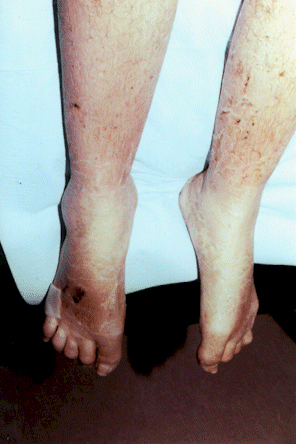Summary
Definition
History and exam
Key diagnostic factors
- history of trauma
- history of immobilization
- female sex
- chronic pain
- limb pain with radiation
- allodynia and hyperalgesia
- body scheme changes
- edema
- trophic skin and nail changes
- erythema or bluish appearance
- local sweating changes or sweating asymmetry
- muscle weakness
Other diagnostic factors
- tremors
- dystonic posturing
- contractures
- sensory loss in glove and stocking distribution
- local changes in hair growth
- skin bullae
Risk factors
- trauma
- immobilization
- female sex
Diagnostic tests
1st tests to order
- no test required: diagnosis is clinical
Tests to consider
- electromyogram
- nerve conduction studies with surface electrodes
- punch skin biopsy
- radiograph of affected limb
- bone scintigraphy with technetium 99m
- dual-energy x-ray absorptiometry (DXA)
- quantitative CT scan
- MRI
- vascular studies
- sympathetic nerve blocks
- intravenous regional or selective anesthetic blocks
Emerging tests
- autonomic testing
Treatment algorithm
early CRPS (within 6 months of onset)
chronic CRPS (>6 months since onset)
Contributors
Authors
Anuj Aggarwal, MD
Clinical Assistant Professor
Anesthesiology, perioperative and pain medicine
Stanford University
Redwood City
CA
Disclosures
AA declares that he has no competing interests.
Acknowledgements
Dr Anuj Aggarwal would like to gratefully acknowledge Dr Nicholas Shenker, Dr Gaurav Chhabra, and Dr Steven H. Horowitz, previous contributors to this topic.
Disclosures
NS is medical adviser to Cambridge Nutraceuticals with stock options. He has received consultancy fees from Roche to provide unrestricted sponsored educational meetings, and grants from Versus Arthritis, the National Institute for Health Research Clinical Research Network, and the Medical Research Council. NS is an author of references cited in this topic. GC has been sponsored by Medtronic, Boston Scientific, Abbott, Nevro, Stimwave, and Polar Medical for attending various conferences and cadaveric workshops relevant to pain medicine and neuromodulation. GC is an associate examiner for the European Society of Regional Anaesthesia & Pain Therapy European Diploma of Pain Medicine exam and is also the regional advisor for pain medicine for the South West Severn deanery. SHH declares that he has no competing interests.
Peer reviewers
Andre Tomasino, MD
Department of Neurological Surgery
Weill Cornell Medical College
New York-Presbyterian Hospital
New York
NY
Disclosures
AT declares that he has no competing interests.
Ari Weinreb, MD, PhD
Associate Chief of Rheumatology
VA Greater Los Angeles Healthcare System
Associate Professor of Medicine
David Geffen School of Medicine
UCLA
Los Angeles
CA
Disclosures
AW declares that he has no competing interests.
Jonathan Berman, MBBS
Consultant in Pain Management and Anaesthesia
Pain Management Department
Royal National Orthopaedic Hospital NHS Trust
Middlesex
UK
Disclosures
JB has been reimbursed by Pfizer for lectures given at Pfizer-sponsored meetings and courses.
Peer reviewer acknowledgements
BMJ Best Practice topics are updated on a rolling basis in line with developments in evidence and guidance. The peer reviewers listed here have reviewed the content at least once during the history of the topic.
Disclosures
Peer reviewer affiliations and disclosures pertain to the time of the review.
References
Key articles
Merskey H, Bogduk N, eds. Classification of chronic pain: descriptions of chronic pain syndromes and definitions of pain terms. 2nd ed. Task force on Taxonomy of the International Association for the Study of Pain. Seattle, WA: IASP Press; 1994:39-43.
Goebel A, Birklein F, Brunner F, et al. The Valencia consensus-based adaptation of the IASP complex regional pain syndrome diagnostic criteria. Pain. 2021 Sep 1;162(9):2346-8.Full text Abstract
Goebel A, Barker C, Birklein F, et al. Standards for the diagnosis and management of complex regional pain syndrome: results of a European Pain Federation task force. Eur J Pain. 2019 Apr;23(4):641-51.Full text Abstract
Harden RN, McCabe CS, Goebel A, et al. Complex regional pain syndrome: practical diagnostic and treatment guidelines, 5th Edition. Pain Med. 2022 Jun 10;23(suppl 1):S1-53.Full text Abstract
Cruccu G, Aziz TZ, Garcia-Larrea L, et al. European Federation of Neurological Societies (EFNS) guidelines on neurostimulation therapy for neuropathic pain. Eur J Neurol. 2007 Sep;14(9):952-70.Full text Abstract
Reference articles
A full list of sources referenced in this topic is available to users with access to all of BMJ Best Practice.

Differentials
- Infection
- Arterial compromise
- Bone pathology
More DifferentialsGuidelines
- Complex regional pain syndrome: practical diagnostic and treatment guidelines, 5th edition
- Complex regional pain syndrome: practical diagnostic and treatment guidelines, 5th edition
More GuidelinesLog in or subscribe to access all of BMJ Best Practice
Use of this content is subject to our disclaimer